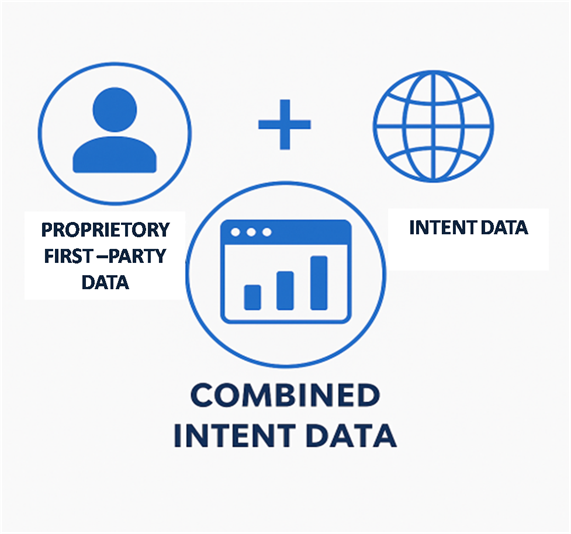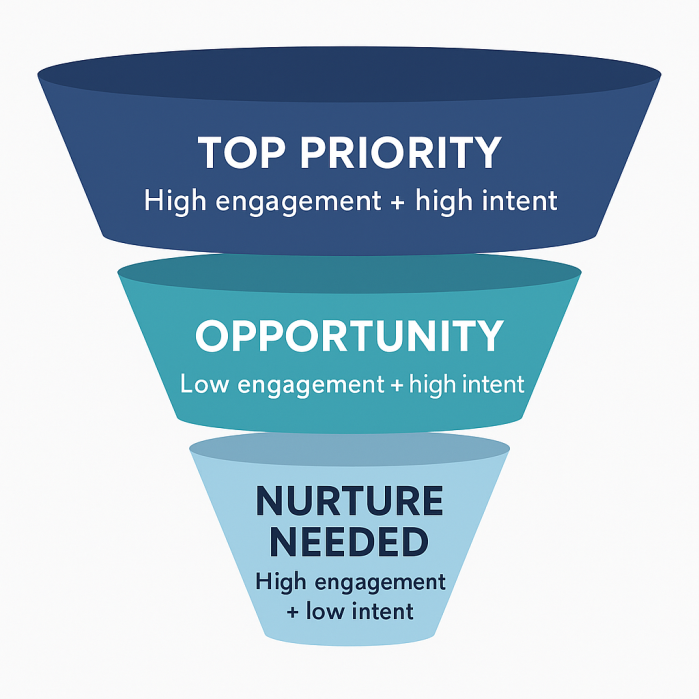Do you ever wonder how top-performing sales teams always seem to be a step ahead, reaching the right buyers at the right time with just the right message?
The power to prioritize outreach and personalize engagement gives your SDR team a definitive competitive edge in today’s overcrowded digital marketplace. Intent data doesn’t just enhance your targeting, it transforms it. By understanding where prospects are in their buying journey, your team can deliver timely, relevant messaging that actually connects.
According to a recent Demand Gen Report, intent data can improve lead conversion rates by up to 35%, while businesses that incorporate intent signals into their lead scoring models experience a 28% shorter sales cycle on average. With sharper lead scoring, SDRs spend more time on accounts that matter, accelerating pipeline velocity and boosting overall ROI.
In this blog, we’ll explore how sales development reps (SDRs) can turn intent signals into conversion opportunities, and how you can do the same.
SDRs Without Intent Data Are Just Beating the Bushes
Picture this: your SDR team is working tirelessly, dialing, emailing, and chasing leads, but without insight into which prospects are actually in-market, much of that effort goes unfocused. It’s like beating the bushes and hoping something valuable jumps out.
Without intent data, SDRs operate on assumptions rather than intelligence. They may reach out to leads with no buying interest, waste time on poorly qualified contacts, and miss high-intent prospects entirely. That means longer sales cycles, lower conversion rates, and more missed opportunities.
At S2W Media, intent data isn’t just a buzzword, it’s a precision tool for modern B2B sales strategy. We define intent data as behavioral signals collected from digital touch points that indicate a prospect’s interest in specific topics, products, or services. These signals may come from content consumption patterns, search behavior, ad interactions, and engagement across the web.
How S2W Media Defines Intent Data and Why It’s a Game Changer for Sales Teams
S2W Media combines first-party and intent data to create a holistic view of buyer behavior. Our proprietary data engine tracks activity across thousands of domains and integrates this with direct engagement data collected through our owned and operated platforms. This dual-source model gives unmatched visibility into where prospects are in their buying journey and what messages they’re most likely to respond to.So why does this matter for your sales team?

Because timing is everything. With intent data, your SDRs are no longer relying on guesswork or cold lists. Instead, they’re prioritizing outreach to accounts already demonstrating interest, reducing waste, shortening sales cycles, and boosting conversion rates.
Benefits of S2W Media’s Intent Data Approach:
Higher Precision
Intent data allows you to move beyond superficial lead lists and into actionable intelligence. By identifying accounts actively researching your solution, related keywords, or even your competitors, SDRs can target companies that are already signaling interest. This level of precision means less guesswork and more engagement with prospects who are further along in their decision-making process resulting in higher quality leads and better win rates.
Improved Personalization
When you know what a prospect is researching, you can tailor your outreach to match their current pain points and priorities. Instead of relying on generic messaging, SDRs can reference specific topics, concerns, or trends the buyer is engaging with. This relevance builds trust faster and positions your brand as a problem-solver not just another cold pitch in their inbox. Personalization grounded in real-time interest leads to more responses and deeper conversations.
Better Timing
Reaching out too early may lead to disinterest. Too late, and the opportunity could already be lost. Intent data gives SDRs the edge of timing alerting them when buyers are in the awareness, consideration, or evaluation stages. This ensures outreach happens when prospects are most receptive, increasing the likelihood of positive engagement and moving them further down the funnel.
Increased ROI
By focusing your SDR efforts on leads with verified buying signals, you're maximizing every minute and dollar spent. Instead of spreading outreach thin across thousands of unqualified names, your team can double down on high-conversion opportunities. This not only increases sales efficiency but also improves ROI from marketing efforts like content syndication, events marketing, and programmatic advertising, by ensuring your pipeline is filled with real potential buyers, not just inquiries.
Intent data is powerful on its own, but when layered with our BANT+ lead qualification model and human-led outreach, it becomes a true game changer for pipeline velocity and sales effectiveness. According to Demand Gen Report, 68% of B2B marketers say intent data improves the performance of ABM campaigns a clear indicator that smarter targeting yields better results.
Prioritizing Outreach with Intent Data
Not all leads are created equal, and your SDR team knows it.

Lead Scoring Gets Smarter
Traditional lead scoring models often rely on surface-level engagement metrics like email opens, website visits, or content downloads. While helpful, these signals don’t always tell the full story about a prospect’s buying intent. That’s where intent data transforms the game.
When enriched with behavioral insights—such as search activity, content consumption trends, and competitor comparisons—your lead scoring becomes exponentially more accurate. It’s no longer just about who’s active; it’s about who’s actively looking to buy.
Here's how smarter lead scoring plays out in action:
• High engagement + high intent = Top Priority
These leads are clearly interested and showing buying behavior. They should be fast-tracked for outreach and personalized sales engagement.
• Low engagement + high intent = Re-engagement Opportunity
These prospects might not be engaging directly with your brand yet, but they’re researching related solutions. With the right message, they can be brought into your funnel.
• High engagement + low intent = Nurture Candidates
These leads are engaging with your content but may not be ready to purchase. Consistent nurturing keeps you top-of-mind until their intent rises.
This dynamic model enables SDRs to prioritize smarter, reduce wasted time on unqualified leads, and engage buyers at the right moment with the right message ultimately shortening sales cycles and increasing conversion rates.
Stat to consider: Companies that incorporate intent data into lead scoring models see a 2.5x increase in conversion rates and a 20%+ reduction in time-to-close, according to a Demand Gen Report.
Still considering whether SDR-as-a-Service is the right move for your organization?
Personalizing Outreach with Intent Signals
Timing alone isn’t enough. Personalization is what makes your message stand out. While reaching out at the right time is critical, timing alone isn’t enough to break through the noise. Personalization is the real differentiator, especially in today’s saturated digital marketplace where buyers are bombarded with templated outreach.
Intent data empowers SDRs to not only know when to reach out, but also what to say and where to say it. This results in messaging that feels relevant, timely, and valuable, rather than generic or intrusive.
Align Messaging with Buyer Intent: Relevance Drives Response
Intent data gives you a front-row seat to your prospect’s research behavior. Whether they’re analyzing costs, comparing vendors, or exploring solutions, you gain visibility into the content they're consuming. This insight allows SDRs to tailor messages with laser precision.
How to craft hyper-relevant outreach based on buyer behavior:
Exploring ROI Calculators? Speak in Value and Numbers
Prospects using ROI calculators are typically focused on justifying investment—either to themselves or to internal stakeholders. This is your cue to lead with quantifiable benefits.
Messaging strategy:
• Highlight potential cost savings, time efficiencies, or productivity improvements.
• Use real metrics from existing clients: “Companies like yours saved 30% on operational costs within 3 months of implementation.”
• Frame your solution as a revenue enabler, not just a tool
• This approach appeals directly to the prospect’s business case preparation phase—helping them build internal buy-in.
Reading Product Comparisons? Emphasize Differentiators
When prospects compare vendors, they’re weighing functionality, compatibility, and support. This stage is critical—they’re closer to a decision, but still evaluating options.
Messaging strategy:
• Showcase key differentiators like advanced features, speed of deployment, security, scalability, or integrations.
• Emphasize customer support excellence, onboarding experience, or tailored service offerings.
• Address potential concerns they may have seen in other products—proactively.
It helps the prospect justify why your solution fits best, especially when they're down to their shortlist.
Content Downloads → Follow Up with Email
If someone downloads a whitepaper, checklist, or report from your site or a syndication platform, it’s a strong buying signal.
Messaging strategy:
• Send an email within 24–48 hours referencing the content and offering next steps.
• Ask a value-driven question: “Was there a particular section you found most relevant to your current strategy?”
Website Visits → Call Immediately (With Context)
High-intent behavior—like repeated visits to your pricing page, demo page, or contact form—signals purchase consideration.
Messaging strategy:
• Call promptly with a message tailored to their last action.
• Reference the specific page they viewed and what it typically signals (e.g., budget evaluation, feature comparison).
Why This Approach Works
When intent-based personalization is paired with precise channel matching, outreach efforts become significantly more effective. According to G2, this approach can boost response rates by up to 70%, while TOPO reports that it leads to 2x more pipeline conversions.
By aligning the right message with the right buyer at the right time—and delivering it through the most responsive channel—teams can dramatically reduce wasted touches.
This multi-layered strategy doesn’t just improve efficiency; it transforms outreach from random noise into resonant engagement, which is a critical differentiator in today’s saturated inboxes and social feeds.
The Role of First-Party Data in Outreach Precision
While third-party data offers valuable early-stage signals, it is first-party data that brings depth, accuracy, and exclusive insights to your outreach strategy. First-party data matters because it’s sourced directly from your brand’s digital touch-points it reflects real user engagement and feeds into precise lead qualification frameworks like BANT+, helping Sales Development Representatives (SDRs) validate Budget, Authority, Need, Timing, and more. In practice, this alignment delivers measurable results.
To assess the real impact, top-performing SDR teams monitor key metrics such as conversion rate per lead source, time-to-first-touch post-signal, meeting-to-opportunity conversion, and overall pipeline influenced by intent-enriched leads.
When powered by both intent and engagement signals, SDRs evolve beyond cold-calling into strategic pipeline builders. They can prioritize high-intent accounts, personalize messaging based on behavioral context, engage on the right channels, and qualify leads more efficiently.
Conclusion: Intent data complements SDR and boosts ROI
This duo of intent and first party data not only enhances productivity—it transforms SDR outreach into a scalable and predictable revenue engine. In a buyer-driven world that demands personalization, relevance, and timeliness, intent data empowers your SDR team to deliver all three with precision and consistency—without adding headcount or relying on guesswork.
At S2W Media, we fuse first-party behavioral data, BANT+-qualified leads, and experienced SDRs to deliver sales-ready opportunities at scale. Ready to elevate your outreach and accelerate pipeline growth? Let’s connect and unlock the full power of intent-driven engagement.



